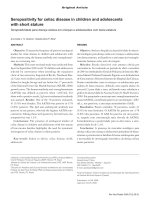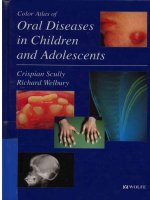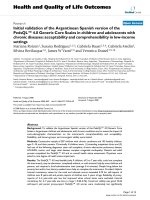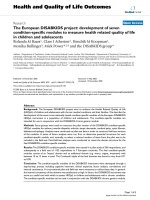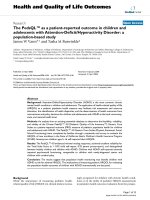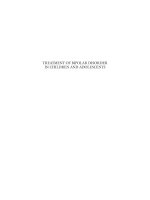ptsd in children and adolescents
Bạn đang xem bản rút gọn của tài liệu. Xem và tải ngay bản đầy đủ của tài liệu tại đây (1.39 MB, 200 trang )
PTSD in Children and
Adolescents
Review of Psychiatry Series
John M. Oldham, M.D.
Michelle B. Riba, M.D., M.S.
Series Editors
No. 1
Washington, DC
London, England
PTSD in Children and
Adolescents
EDITED BY
Spencer Eth, M.D.
Note: The authors have worked to ensure that all information in this book
concerning drug dosages, schedules, and routes of administration is accurate as
of the time of publication and consistent with standards set by the U.S. Food and
Drug Administration and the general medical community. As medical research
and practice advance, however, therapeutic standards may change. For this
reason and because human and mechanical errors sometimes occur, we
recommend that readers follow the advice of a physician who is directly involved
in their care or the care of a member of their family. A product’s current package
insert should be consulted for full prescribing and safety information.
Books published by American Psychiatric Publishing, Inc., represent the views
and opinions of the individual authors and do not necessarily represent the
policies and opinions of APPI or the American Psychiatric Association.
Copyright © 2001 American Psychiatric Publishing, Inc.
04 03 02 01 4 3 2 1
ALL RIGHTS RESERVED
Manufactured in the United States of America on acid-free paper
First Edition
American Psychiatric Publishing, Inc.
1400 K Street, NW
Washington, DC 20005
www.appi.org
The correct citation for this book is
Eth S (editor): PTSD in Children and Adolescents (Review of Psychiatry Series,
Volume 20, Number 1; Oldham JM and Riba MB, series editors). Washington,
DC, American Psychiatric Publishing, 2001
Library of Congress Cataloging-in-Publication Data
PTSD in children and adolescents / edited by Spencer Eth.
p. ; cm — (Review of Psychiatry ; v. 20, no. 1)
Includes bibliographical references and index.
ISBN 1-58562-026-2 (alk. paper)
1. Post-traumatic stress disorder in children. 2. Teenagers—Mental health.
[DNLM: 1. Stress Disorders, Post-Traumatic—diagnosis—Adolescence.
2. Stress Disorders, Post-Traumatic—diagnosis—Child. 3. Stress
Disorders, Post-Traumatic—therapy—Adolescence. 4. Stress Disorders,
Post-Traumatic—therapy—Child. 5. Forensic Psychiatry—methods. 6.
Psychotherapy—methods—Adolescence. 7. Psychotherapy—methods—
Child. WM 170 P975 2001] I. Title: Post-traumatic stress disorder in
children and adolescents. II. Eth, Spencer, 1950- III. Review of psychiatry
series ; v. 20, 1
RJ506.P55 .P875 2001
616.85′21—dc21
00-067404
British Library Cataloguing in Publication Data
A CIP record is available from the British Library.
Cover photograph: Copyright © 2001 David Oliver/Stone.
To my wife, Cheryl, a woman
of kindness and valor.
Contents
Contributors xi
Introduction to the Review of Psychiatry Series xiii
John M. Oldham, M.D., and
Michelle B. Riba, M.D., M.S., Series Editors
Introduction: Childhood Trauma in Perspective xvii
Spencer Eth, M.D.
Chapter 1
Evaluation and Assessment of PTSD in
Children and Adolescents 1
Evan B. Drake, Ph.D.
Sherry F. Bush, Ph.D.
Wilfred G. van Gorp, Ph.D.
Introduction 1
Issues in the Assessment of
Children and Adolescents 1
Clinical Guidelines for Assessment 4
Recent Developments in Clinical Assessment 5
Multidimensional Approach to Assessment 15
Conclusions 26
References 27
Chapter 2
Forensic Aspects of PTSD in
Children and Adolescents 33
James E. Rosenberg, M.D.
Introduction 33
Diagnosis 34
Epidemiology 38
Genetics 39
Risk Factors in Various Settings 39
Psychophysiology 44
Assessment 45
PTSD and Memory 47
Treatment 50
Conclusions and Recommendations 51
References 54
Chapter 3
PTSD in Children and Adolescents in the
Juvenile Justice System 59
William Arroyo, M.D.
Introduction 59
Demographics 60
Mental Disorders 61
Posttraumatic Stress Disorder 62
Incarcerated Youth 63
Female Population 65
Predisposing Factors 65
Interventions 70
Special National Challenge 77
Summary 78
References 79
Chapter 4
Biological Treatment of PTSD in
Children and Adolescents 87
Soraya Seedat, M.B.
Dan J. Stein, M.B.
Diagnosis and Phenomenology 88
Neurobiologic Systems in PTSD 90
Biologic Treatments in Children and Adolescents 94
Assessing Outcome in Children and Adolescents 104
Quality of Life 105
Conclusions 105
References 107
Chapter 5
Relationship Between Childhood Traumatic
Experiences and PTSD in Adults 117
Rachel Yehuda, Ph.D.
Ilyse L. Spertus, Ph.D.
Julia A. Golier, M.D.
Introduction 117
Long-Term Consequences of Childhood
Maltreatment—Sexual Abuse, Physical
Abuse, Emotional Abuse, and/or Neglect 118
Challenges in Formulating a
Model of the Effects of Early
Child Maltreatment on the Adult 124
Long-Term Consequences of Single-Episode
Traumatic Events: Preliminary Evidence 125
Prevalence of PTSD in Children and
Adults Following Childhood Trauma 127
Impact of Early Maltreatment on
Reaction to Subsequent Trauma and
Risk of Revictimization 129
Biological Models of the Effects of Stress:
The Centrality of Sensitization as a
Mechanism of Permanent Stress Responses 132
Developmental Influences of
Early Stress in Animals 133
Biological Consequences in Adults
Who Experienced Trauma in Childhood 135
PTSD and Other Psychological
Symptoms in Adults Who
Survived the Holocaust as Children 141
Methodologic Considerations in the Study of
the Long-Term Impact of Childhood Trauma 143
Summary and Conclusions 146
References 146
Index 159
Contributors xi
Contributors
William Arroyo, M.D.
Clinical Assistant Professor, Psychiatry and Behavioral Sciences, Keck
School of Medicine, University of Southern California, Los Angeles,
California
Sherry F. Bush, Ph.D.
Assistant Professor, Department of Psychology, Fordham University,
New York, New York
Evan B. Drake, Ph.D.
Chief, Neuropsychology Section, Department of Psychology, Mount
Carmel Guild Behavioral Healthcare System, Catholic Community
Services, Newark, New Jersey
Spencer Eth, M.D.
Professor and Vice Chairman, Department of Psychiatry and
Behavioral Sciences, New York Medical College; and Medical
Director, Behavioral Health Services, Saint Vincent Catholic Medical
Centers, New York, New York
Julia A. Golier, M.D.
Traumatic Stress Studies Program, Department of Psychiatry, Mount
Sinai School of Medicine, New York, New York
John M. Oldham, M.D.
Dollard Professor and Acting Chairman, Department of Psychiatry,
Columbia University College of Physicians and Surgeons, New York,
New York
Michelle B. Riba, M.D., M.S.
Associate Chair for Education and Academic Affairs, Department of
Psychiatry, University of Michigan Medical School, Ann Arbor,
Michigan
xii PTSD IN CHILDREN AND ADOLESCENTS
James E. Rosenberg, M.D.
Assistant Clinical Professor of Psychiatry, University of California–
Los Angeles School of Medicine, Los Angeles, California; Director,
Forensic Neuropsychiatry Medical Group, Inc., Westlake Village,
California
Soraya Seedat, M.B.
Medical Research Council Unit on Anxiety Disorders, University of
Stellenbosch, Cape Town, South Africa
Ilyse L. Spertus, Ph.D.
Traumatic Stress Studies Program, Department of Psychiatry, Mount
Sinai School of Medicine, New York, New York
Dan J. Stein, M.B.
Medical Research Council Unit on Anxiety Disorders, University of
Stellenbosch, Cape Town, South Africa, and University of Florida,
Gainesville, Florida
Wilfred G. van Gorp, Ph.D.
Professor, Department of Psychiatry, Weill Medical College of Cornell
University, New York, New York
Rachel Yehuda, Ph.D.
Traumatic Stress Studies Program, Department of Psychiatry, Mount
Sinai School of Medicine, New York, New York
Introduction to the Review of Psychiatry Series xiii
Introduction to the Review
of Psychiatry Series
John M. Oldham, M.D., and
Michelle B. Riba, M.D., M.S., Series Editors
2001 REVIEW OF PSYCHIATRY SERIES TITLES
• PTSD in Children and Adolescents
E
DITED BY SPENCER ETH, M.D.
• Integrated Treatment of Psychiatric Disorders
E
DITED BY JERALD KAY, M.D.
• Somatoform and Factitious Disorders
E
DITED BY KATHARINE A. PHILLIPS, M.D.
• Treatment of Recurrent Depression
E
DITED BY JOHN F. GREDEN, M.D.
• Advances in Brain Imaging
E
DITED BY JOHN M. MORIHISA, M.D.
In today’s rapidly changing world, the dissemination of infor-
mation is one of its rapidly changing elements. Information vir-
tually assaults us, and proclaimed experts abound. Witness, for
example, the 2000 presidential election in the United States, dur-
ing which instant opinions were plentiful about the previously
obscure science of voting machines, the electoral college, and the
meaning of the words of the highest court in the land. For medi-
cine the situation is the same: the World Wide Web virtually bulg-
es with health advice, treatment recommendations, and strident
warnings about the dangers of this approach or that. Authorita-
tive and reliable guides to help the consumer differentiate be-
tween sound advice and unsubstantiated opinion are hard to
xiv PTSD IN CHILDREN AND ADOLESCENTS
come by, and our patients and their families may be misled by
bad information without even knowing it.
At no time has it been more important, then, for psychiatrists
and other clinicians to be well informed, armed with the very lat-
est findings, and well versed in evidence-based medicine. We
have designed Volume 20 of the Review of Psychiatry Series with
these trends in mind—to be, if you will, a how-to manual: how to
accurately identify illnesses, how to understand where they come
from and what is going wrong in specific conditions, how to mea-
sure the extent of the problem, and how to design the best treat-
ment, especially for the particularly difficult-to-treat disorders.
The central importance of stress as a pathogen in major mental
illness throughout the life cycle is increasingly clear. One form of
stress is trauma. Extreme trauma can lead to illness at any age, but
its potential to set the stage badly for life when severe trauma oc-
curs during early childhood is increasingly recognized. In PTSD
in Children and Adolescents, Spencer Eth and colleagues review the
evidence from animal and human studies of the aberrations, both
psychological and biological, that can persist throughout adult-
hood as a result of trauma experienced during childhood. Newer
technologies have led to new knowledge of the profound nature
of some of these changes, from persistently altered stress hor-
mones to gene expression and altered protein formation. In turn,
hypersensitivities result from this early stress-induced biological
programming, so that cognitive and emotional symptom patterns
emerge rapidly in reaction to specific environmental stimuli.
Nowhere in the field of medicine is technology advancing
more rapidly than in brain imaging, generating a level of excite-
ment that surely surpasses the historical moment when the dis-
covery of the X ray first allowed us to noninvasively see into the
living human body. The new imaging methods, fortunately, do
not involve the risk of radiation exposure, and the capacity of the
newest imaging machines to reveal brain structure and function
in great detail is remarkable. Yet in many ways these techniques
still elude clinical application, since they are expensive and in-
creasingly complex to administer and interpret. John Morihisa
has gathered a group of our best experts to discuss the latest de-
velopments in Advances in Brain Imaging, and the shift toward
Introduction to the Review of Psychiatry Series xv
greater clinical utility is clear in their descriptions of these meth-
ods. Perhaps most intriguing is the promise that through these
methods we can identify, before the onset of symptoms, those
most at risk of developing psychiatric disorders, as discussed by
Daniel Pine regarding childhood disorders and by Harold Sack-
eim regarding late-life depression.
Certain conditions, such as the somatoform and factitious dis-
orders, can baffle even our most experienced clinicians. As
Katharine Phillips points out in her foreword to Somatoform and
Factitious Disorders, these disorders frequently go unrecognized
or are misdiagnosed, and patients with these conditions may be
seen more often in the offices of nonpsychiatric physicians than
in those of psychiatrists. Although these conditions have been re-
ported throughout the recorded history of medicine, patients
with these disorders either are fully convinced that their prob-
lems are “physical” instead of “mental” or choose to present their
problems that way. In this book, experienced clinicians provide
guidelines to help identify the presence of the somatoform and
factitious disorders, as well as recommendations about their
treatment.
Treatment of all psychiatric disorders is always evolving,
based on new findings and clinical experience; at times, the field
has become polarized, with advocates of one approach vying
with advocates of another (e.g., psychotherapy versus pharma-
cotherapy). Patients, however, have the right to receive the best
treatment available, and most of the time the best treatment in-
cludes psychotherapy and pharmacotherapy, as detailed in Inte-
grated Treatment of Psychiatric Disorders. Jerald Kay and colleagues
propose the term integrated treatment for this approach, a recom-
mended fundamental of treatment planning. Psychotherapy
alone, of course, may be the best treatment for some patients, just
as pharmacotherapy may be the mainstay of treatment for others,
but in all cases there should be thoughtful consideration of a
combination of these approaches.
Finally, despite tremendous progress in the treatment of most
psychiatric disorders, there are some conditions that are stub-
bornly persistent in spite of the best efforts of our experts. John
Greden takes up one such area in Treatment of Recurrent Depres-
xvi PTSD IN CHILDREN AND ADOLESCENTS
sion, referring to recurrent depression as one of the most dis-
abling disorders of all, so that, in his opinion, “a call to arms” is
needed. Experienced clinicians and researchers review optimal
treatment approaches for this clinical population. As well, new
strategies, such as vagus nerve stimulation and minimally inva-
sive brain stimulation, are reviewed, indicating the need to go be-
yond our currently available treatments for these seriously ill
patients.
All in all, we believe that Volume 20 admirably succeeds in ad-
vising us how to do the best job that can be done at this point to
diagnose, understand, measure, and treat some of the most chal-
lenging conditions that prompt patients to seek psychiatric help.
Introduction xvii
Introduction
Childhood Trauma in Perspective
Spencer Eth, M.D.
In 1985, the American Psychiatric Press published Post-Traumatic
Stress Disorder in Children (Eth and Pynoos 1985b). This slim vol-
ume, which was edited by myself and Dr. Robert S. Pynoos, con-
tained nine chapters, many of which were originally presented in
a symposium during the May 1984 annual meeting of the Amer-
ican Psychiatric Association in Los Angeles, California. A suc-
cess, the book rode a wave of interest in what was then a new
concern for psychiatrists—the psychologic impact of traumatic
events in the lives of children.
The monograph you are reading now, PTSD in Children and
Adolescents, which is part of the 2001 Review of Psychiatry series,
reflects the maturation of the field of “developmental psy-
chotraumatology.” Clinical practices in childhood trauma are to-
day based on a wealth of research and case studies found in
hundreds, if not thousands, of publications in the scientific liter-
ature. It is with a sense of pride for this progress that we contrast
the respective states of knowledge captured in these two works.
Prior to the 1980 publication of the DSM-III (American Psychi-
atric Association 1980), posttraumatic stress disorder (PTSD) did
not exist. Except, of course, that it did. For, unlike acquired im-
mune deficiency syndrome (AIDS), PTSD is an affliction that has
plagued mankind since our prehistoric ancestors were attacked
by predatory animals, were devastated by natural disasters, and
engaged in tribal warfare. Many authors have delighted in find-
ing literary descriptions characteristic of PTSD in various fiction
and nonfiction works dating back to Homer (Daly 1983).
xviii PTSD IN CHILDREN AND ADOLESCENTS
The modern era of traumatic studies may be said to have be-
gun with World War I, when soldiers were routinely exposed to
death and devastation on an unprecedented scale. The term shell
shock was applied to those soldiers who responded to combat
with severe psychiatric symptoms. Although first believed to be
an emotional manifestation of brain injury, shell shock came to be
accepted as having a psychological etiology (Hynes 1997). Freud,
having observed victims of shell shock, suggested that an un-
bearable situation could itself be pathologic. Contrary to his usu-
al emphasis on regression to forbidden infantile fantasies, Freud
reasoned that real-life trauma confronts the mind with affects too
powerful to be assimilated, thereby overwhelming the stimulus
barrier. In his final work, Moses and Monotheism, published at the
time of his death in 1939, Freud conceptualized psychic trauma
as composed of two types of symptoms: positive effects, which are
fixations to the trauma and repetition compulsions, and negative
effects, which are the defensive reactions of avoidance, inhibition,
and phobia (Freud 1939/1962). These formulations are analo-
gous to the DSM-III–defined symptom clusters of reexperiencing
and numbing.
World War II, the European Holocaust, and the atomic bomb-
ing of Hiroshima highlighted the psychiatric sequela of massive
psychic trauma. In particular, adult prisoners of war and survi-
vors of the concentration camps were often found to be suffering
from severe posttraumatic syndromes that persisted or worsened
over the course of years despite intensive treatment (Krystal
1968). For the first time, there began to appear in the professional
literature case reports of children who had been dislocated, or-
phaned, injured, or incarcerated during the war. Because of the
broad range of age and circumstances of these children and the
theoretical orientation and methodology of the authors, these pa-
pers failed to convey a consistent clinical picture. In retrospect,
the data collected were probably overly dependent on informa-
tion provided by parents and other secondary sources who may
have wished to deny the gravity of the children’s emotional pain.
For example, Anna Freud failed to detect “signs of traumatic
shock” in the youngsters in her war nursery (Freud and Burling-
ham 1943).
Introduction xix
The first rigorous investigation of childhood trauma was con-
ducted in the wake of the Vicksburg, Mississippi, tornado of De-
cember 1953. One week after the disaster, two child psychiatrists
spoke with children, parents, and community members and then
distributed questionnaires. They found a significant association
between being severely disturbed and having been within the
tornado’s impact zone. They also noted the appearance of “torna-
do games” in some children’s play (Bloch et al. 1956). In 1972 an-
other child psychiatrist reported clinical observations of fears in
56 children whose Welsh school had been engulfed in an ava-
lanche of slag (Lacey 1972).
A landmark series of studies arose from a West Virginia disas-
ter—the February 1972 Buffalo Creek slag dam collapse and
flood. The filing of a lawsuit by the downstream residents result-
ed in psychiatric evaluations of the plaintiffs, including 224 chil-
dren. One early publication described the “after-trauma”
vulnerabilities of those victims who were under 12 years of age
at the time of the flood (Newman 1976). A 17-year follow-up of
this group of children found PTSD in 7% (all female) compared
with 32% who were retrospectively diagnosed as having PTSD in
the aftermath of the flood (Green et al. 1994).
The last major pre-DSM-III child trauma study was Dr. Lenore
Terr ’s work with the children of Chowchilla. In July 1976, 26 Cal-
ifornia schoolchildren and their bus driver were kidnapped and
buried alive in a van for 16 hours before escaping. Dr. Terr ini-
tially interviewed the children and then later, in separate re-
search projects, conducted follow-up interviews of the victims
and a comparison with a matched group of children from a sim-
ilar town as control subjects. These studies forcefully established
that traumatized children exhibited a unique constellation of
signs and symptoms that can be understood in the context of
their struggles to master their experience (Terr 1979). One aspect
of this data set became the basis of Terr’s chapter in Post-
Traumatic Stress Disorder in Children (Terr 1985). In another chap-
ter, Benedek (1985) chronicled the professional hostility that
greeted Dr. Terr’s first presentation of her findings, a reaction
reminiscent of the rejecting response to the early accounts of
child abuse.
xx PTSD IN CHILDREN AND ADOLESCENTS
The introduction of the DSM-III in 1980 provided the name of
a new disorder, posttraumatic stress disorder, and in so doing
served to organize the field of traumatic stress. PTSD was de-
fined by its diagnostic criteria, which consisted of a definition of
the traumatic stressor and three clusters of symptoms: 1) reexpe-
riencing of the trauma (such as intrusive memories and night-
mares of the event); 2) numbing of responsiveness to or reduced
involvement with the external world (such as detachment and
constricted affect); and 3) arousal (such as exaggerated startle re-
actions and sleep disturbance).
The creation of the PTSD diagnosis has been viewed as politi-
cally driven by the vocal demands of two special interest factions
and their supporters—American veterans of the Vietnam War
and adult women rape victims (Leys 2000). The absence of chil-
dren in these populations may perhaps explain why DSM-III was
silent about how PTSD would appear in children. None of the
new diagnostic criteria contained explicit references to children.
Clinicians were left to wonder: Does PTSD exist during child-
hood as a specific disorder? If so, should it be assumed that the
condition presents identically regardless of gender, age, and de-
velopmental phase?
Certain distinguished child mental health experts opined that
this form of stress disorder is not markedly different from other
emotional disorders not precipitated by severely traumatic expe-
riences (Garmezy and Rutter 1985). A contrary position was as-
serted in Post-Traumatic Stress Disorder in Children (Eth and
Pynoos 1985b), wherein the prevalence of PTSD in special popu-
lations of children was carefully demonstrated. Using the DSM-
III adult criteria for PTSD, authors readily diagnosed the disorder
in various groups of children at risk for exposure to traumatic
events.
Arroyo and Eth (1985) interviewed child refugees from the civ-
il wars that were endemic in Central America. Excellent studies
of the phenomenology, prevalence, and course of PTSD in South-
east Asian child immigrants soon followed (Sack et al. 1999). The
destructive legacy of the exposure to violence in children from
war zones and certain inner-city neighborhoods is, by now, well
established (Apfel and Simon 1996). In Chapter 3 of this book,
Introduction xxi
Dr. Arroyo extends this work by examining the role of trauma in
the lives of juvenile offenders. Similarly, Nir (1985) described the
presence of iatrogenic PTSD in young cancer patients, a line of in-
quiry that has been pursued further in the pediatric consultation-
liaison field (Stuber et al. 1997).
Physical abuse and sexual abuse can be experienced as trau-
matic; however, these acts are often repeated many times over the
course of years in a child’s life. Green (1985) delineated the dis-
turbed psychodynamics and family interactions in abusive
homes, whereas Goodwin (1985) examined the occurrence of
traumatic symptoms in incest victims. Since that time, Terr (1991)
has proposed the existence of two types of childhood traumatic
syndromes that reflect fundamental differences between children
exposed to single traumatic events and those experiencing chron-
ic, multiple traumas.
In 1987, DSM-III-Revised was published (American Psychiat-
ric Association 1987). Unlike its predecessor, DSM-III, this new
edition contained two “child-friendly” examples among the di-
agnostic criteria for PTSD. The reexperiencing symptom of recur-
rent and intrusive distressing recollections can be satisfied in
young children through repetitive play, in which themes or as-
pects of the trauma are expressed, such as the “tornado games”
mentioned earlier. The numbing of responsiveness criterion of
markedly diminished interest in significant activities may be ful-
filled in young children by the loss of recently acquired develop-
mental skills such as toilet training.
DSM-IV (American Psychiatric Association 1994) is notewor-
thy for its revision of the stressor criterion from a traumatic event
that is outside the range of usual human experience and would
be markedly distressing to almost anyone to a traumatic event
that involved actual or threatened death or a serious injury that
involved intense fear, helplessness, or horror. This new criterion
recognizes that in many locations around the world violence is
endemic, such that traumatic events cannot be considered out-
side of the range of usual human experience. DSM-IV notes that
in children, the experience of traumatic stress can be expressed
by disorganized or agitated behavior. In addition, the reexperi-
encing symptom of distressing dreams of the traumatic event in
xxii PTSD IN CHILDREN AND ADOLESCENTS
children can take the form of frightening dreams without recogniz-
able content (a night terror). DSM-IV also introduces trauma-specif-
ic reenactment as the child example of the reexperiencing symptom
of acting or feeling as if the traumatic event were recurring.
DSM-III, DSM-III-R, and DSM-IV have no specific diagnostic
category for traumatic grief, although the DSMs do contain a
V-code for bereavement that can be used when the focus of clin-
ical attention is a “normal” reaction to the death of a loved one. If
the sadness associated with the death is more severe and persis-
tent, a diagnosis of major depressive disorder may be made. Py-
noos and Eth (1985) reviewed their work with children who
witnessed acts of extreme violence involving a parent, including
homicide and suicide. They further (Eth and Pynoos 1985a) de-
scribed circumstances in which the grieving process of children
was disrupted by the traumatic circumstances of a parent’s
death. An understanding of the interplay of trauma and grief is
critical in order to help the affected child mourn successfully. Re-
cently, Prigerson et al. (1999) devised and tested criteria for the
condition of traumatic grief in adults, whereas Stoppelbein and
Greening (2000) reported on symptoms of posttraumatic stress in
parentally bereaved children and adolescents.
Frederick (1985) was a pioneer in the use of a standardized in-
strument (the reaction index) to measure the severity of traumat-
ic symptoms in children. Rating scales have since proven
invaluable in both their research applications and their clinical
applications. In Chapter 1, Drake, Bush, and van Gorp present an
overview of the evaluation of PTSD in children and adolescents
that surveys various instruments shown to have value in assess-
ing children and adolescents.
The language and metaphor of psychoanalysis informed much
of the early literature on childhood trauma. Over the past decade,
the construct chosen for understanding the traumatic process has
been increasingly biologic (Pfefferbaum 1997). There is a sense
that breakthroughs in delineating the neurophysiologic diathesis
of trauma are already on the horizon (Heim et al. 2000). Although
the targeted application of this progress to specific, biologically
based therapies is premature, psychopharmacologic agents are in
widespread use for treating traumatized children and adoles-
Introduction xxiii
cents both in the United States (American Academy of Child and
Adolescent Psychiatry 1998) and abroad (Perrin et al. 2000). Seed-
at and Stein provide a comprehensive review of the important
role of medication in clinical practice in Chapter 4.
From the Buffalo Creek disaster (Lindy and Titchener 1983) to
today’s toxic torts (Harr 1995), litigation has been a catalyst in
stimulating the study of traumatized children and adolescents.
Furthermore, many clinicians have been called to testify as expert
witnesses about PTSD. However, even psychiatrists well versed
on the subject of trauma may feel uncomfortable with judicial
procedures and intimidated in a courtroom setting. In Chapter 2,
Rosenberg familiarizes the reader with issues that are especially
pertinent to the practice of forensic psychiatry, such as the reli-
ability of traumatic memories in children.
One question that is usually asked of the expert witness testi-
fying about PTSD is the prognosis for the affected child or ado-
lescent. Do we know enough about risk and resiliency factors to
make informed predictions about the natural history of child-
hood PTSD? The life course of child survivors of the Holocaust
(Kestenberg and Brenner 1996) has been extensively studied, but
the generalizability of these findings is unclear. In Chapter 5, Ye-
huda, Spertus, and Golier offer a comprehensive analysis of the
literature and their own work in addressing the relationship be-
tween early trauma exposure, biologic substrates, and the subse-
quent development of PTSD in adulthood.
It is indeed a blessing that the field of child and adolescent
PTSD has been transformed from an uncharted territory to a
community crowded with investigators, practitioners, and ex-
citement (Sugar 1999; Yule 2000). This book should find its place
as a roadmap for clinicians seeking to expand their horizons in
treating traumatized youth.
References
American Academy of Child and Adolescent Psychiatry: Practice pa-
rameters for the assessment and treatment of children and adoles-
cents with posttraumatic stress disorder. J Am Acad Child Adolesc
Psychiatry 37(suppl):4S–26S, 1998
xxiv PTSD IN CHILDREN AND ADOLESCENTS
American Psychiatric Association: Diagnostic and Statistical Manual of
Mental Disorders, 3rd Edition. Washington, DC, American Psychiat-
ric Association, 1980
American Psychiatric Association: Diagnostic and Statistical Manual of
Mental Disorders, 3rd Edition Revised. Washington, DC, American
Psychiatric Association, 1987
American Psychiatric Association: Diagnostic and Statistical Manual of
Mental Disorders, 4th Edition. Washington, DC, American Psychiat-
ric Association, 1994
Apfel RJ, Simon B (eds): Minefields in their Hearts: the Mental Health
of Children in War and Communal Violence. New Haven, CT, Yale
University Press, 1996
Arroyo W, Eth S: Children traumatized by Central American warfare,
in Post-Traumatic Stress Disorder in Children. Edited by Eth S,
Pynoos RS. Washington, DC, American Psychiatric Press, 1985,
pp 101–120
Benedek EP: Children and psychic trauma: a brief review of contempo-
rary thinking, in Post-Traumatic Stress Disorder in Children. Edited
by Eth S, Pynoos RS. Washington, DC, American Psychiatric Press,
1985, pp 1–16
Bloch DA, Silber E, Perry SE: Some factors in the emotional reactions of
children to disaster. Am J Psychiatry 113:416–422, 1956
Daly RJ: Samuel Pepys and post-traumatic stress disorder. Br J Psychia-
try 143:64–68, 1983
Eth S, Pynoos RS: Interaction of trauma and grief in childhood, in Post-
Traumatic Stress Disorder in Children. Edited by Eth S, Pynoos RS.
Washington, DC, American Psychiatric Association, 1985a, pp 169–
186
Eth S, Pynoos RS (eds): Post-Traumatic Stress Disorder in Children.
Washington, DC, American Psychiatric Press, 1985b
Frederick CJ: Children traumatized by catastrophic situations, in Post-
Traumatic Stress Disorder in Children. Edited by Eth S, Pynoos RS.
Washington, DC, American Psychiatric Association, 1985, pp 71–100
Freud A, Burlingham D: War and Children. London, England, Medical
War Books, 1943
Freud S: Moses and Monotheism (1939), in The Standard Edition of the
Complete Psychological Works of Sigmund Freud, Vol 20. Translated
and edited by Strachey J. London, England, Hogarth Press, 1962
Garmezy N, Rutter M: Acute reactions to stress, in Child and Adoles-
cent Psychiatry: Modern Approaches, 2nd Edition. Edited by Rutter
M, Hersov L. Oxford, England, Blackwell Scientific, 1985, pp 152–176
Introduction xxv
Goodwin, J: Post-traumatic symptoms in incest victims, in Post-Trau-
matic Stress Disorder in Children. Edited by Eth S, Pynoos RS. Wash-
ington, DC, American Psychiatric Press, 1985, pp 155–168
Green AH: Children traumatized by physical abuse, in Post-Traumatic
Stress Disorder in Children. Edited by Eth S, Pynoos RS. Washington,
DC, American Psychiatric Press, 1985, pp 133–154
Green BL, Grace MC, Vary MG, et al: Children of disaster in the second
decade: a 17-year follow-up of Buffalo Creek survivors. J Am Acad
Child Adolesc Psychiatry 33:71–79, 1994
Harr J: A Civil Action. New York, Random House, 1995
Heim C, Newport DJ, Heit S, et al: Pituitary–adrenal and autonomic re-
sponses to stress in women after sexual and physical abuse in child-
hood. JAMA 284:592–597, 2000
Hynes S: The Soldiers’ Tale: Bearing Witness to Modern War. New York,
Penguin, 1997
Kestenberg JS, Brenner I: The Last Witness: The Child Survivor of the
Holocaust. Washington, DC, American Psychiatric Press, 1996
Krystal H (ed): Massive Psychic Trauma. New York, International Uni-
versities Press, 1968
Lacey GN: Observations on Aberfan. J Psychosom Res 16:257–260, 1972
Leys R: Trauma: A Genealogy. Chicago, IL, University of Chicago Press,
2000
Lindy JD, Titchener J: “Acts of God and man”: long-term character
change in survivors of disasters and the law. Behavioral Sciences and
the Law 1:85–96, 1983
Newman CJ: Children of disaster: clinical observations at Buffalo
Creek. Am J Psychiatry 133:306–312, 1976
Nir Y: Post-traumatic stress disorder in children with cancer, in Post-
Traumatic Stress Disorder in Children. Edited by Eth S, Pynoos RS.
Washington, DC, American Psychiatric Press, 1985, pp 121–132
Perrin S, Smith P, Yule W: Practitioner review: the assessment and treat-
ment of post-traumatic stress disorder in children and adolescents.
J Child Psychol Psychiatry 41:277–289, 2000
Pfefferbaum B: Posttraumatic stress disorder in children: a review of the
past 10 years. J Am Acad Child Adolesc Psychiatry 36:1503–1511, 1997
Prigerson HG, Shear MK, Jacobs SC, et al: Consensus criteria for trau-
matic grief: a preliminary empirical test. Br J Psychiatry 44:67–73, 1999
Pynoos RS, Eth S: Children traumatized by witnessing acts of personal
violence: homicide, rape, or suicide behavior, in Post-Traumatic
Stress Disorder in Children. Edited by Eth S, Pynoos RS. Washington,
DC, American Psychiatric Press, 1985, pp 17–44
